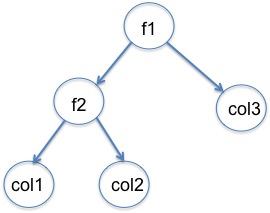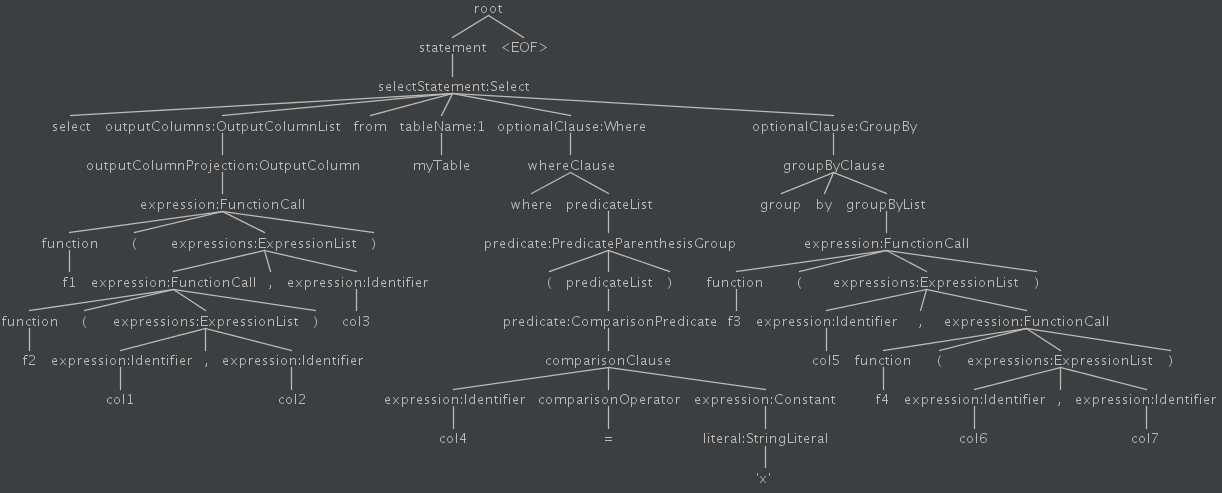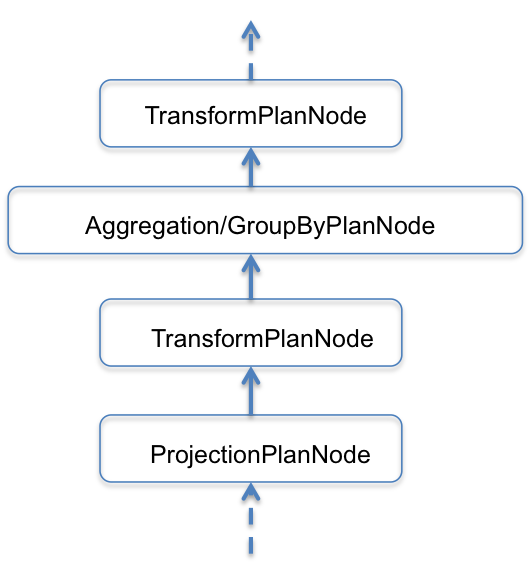Expressions and UDFs¶
Requirements¶
The query language for Pinot (PQL) currently only supports selection, aggregation & group by operations on columns, and moreover, do not support nested operations. There are a growing number of use-cases of Pinot that require some sort of transformation on the column values, before and/or after performing selection, aggregation & group by. One very common example is when we would want to aggregate metrics over different granularity of times, without needing to pre-aggregate records on the individual granularity outside of Pinot. Another example would be when we would want to aggregate on function (say difference) of multiple columns.
The high level requirement here is to support expressions that represent a function on a set of columns in the queries, as opposed to just columns.
select <exp1> from myTable where ... [group by <exp2>]
Where exp1 and exp2 can be of the form:
func1(func2(col1, col2...func3(...)...), coln...)...
Proposal¶
We first propose the concept of a Transform Operator (xform) below. We then propose using these xform operators to perform transformations before/after selection, aggregation and group by operations.
The xform operator takes following inputs:
- An expression tree capturing functions and the columns they are applied on. The figure below shows one such tree for expression:
f1(f2(col1, col2), col3) - A set of document Id’s on which to perform xform

The xform produces the following output:
- For each document Id in the input, it evaluates the specified expression, and produces one value.
- It is Many:1 for columns, i.e. many columns in the input produce one column value in the output.
- It is 1:1 for document Id’s, i.e. for each document in the input, it produces one value in the output.
The functions in the expression can be either built-in into Pinot, or can be user-defined. We will discuss the mechanism for hooking up UDF and the manageability aspects in later sections.
Parser¶
The PQL parser is already capable of parsing expressions in the selection, aggregation and group by sections. Following is a sample query containing expression, and its parse tree shown in the image.
select f1(f2(col1, col2), col3) from myTable where (col4 = 'x') group by f3(col5, f4(col6, col7))

BrokerRequest¶
We convert the Parse Tree from the parser into what we refer to as BrokerRequest, which captures the parse tree along with other information and is serialized from Pinot broker to server. While the parser does already recognize expressions in these sections, the BrokerRequest currently assumes these to be columns and not expressions. We propose the following enhancements here:
- BrokerRequest needs to be enhanced to support not just columns but also expressions in the selection, aggregation & group by sections. BrokerRequest is currently implemented via ‘Thrift’. We will need to enhance request.thrift to be able to support expressions. There are a couple of options here:
- We use the same mechanism as FilterQuery (which is how the predicates are represented).
- Evaluate other structures that may be more suitable for expression evaluation. (TBD).
- The back-end of the parser generates BrokerRequest based on the parse tree of the query. We need to implement the functionality that takes the parse tree containing expressions in these sections and generates the new/enhanced BrokerRequest containing expressions.
Query Planning¶
In the query planning phase, Pinot server receives a BrokerRequest (per query) and parses it to build a query plan, where it hooks up various plan nodes for filtering, Selection/Aggregation/GroupBy, combining together.
A new TransformPlanNode class will be implemented that implements the PlanNode interface. The query planning phase will be enhanced to include new xform plan nodes if the BrokerRequest contains expressions for selection, aggregation & group by. These plan nodes will get hooked up appropriately during planning phase.

Query Execution¶
In the query execution phase, the run method for TransformPlanNode will return a new TransformOperator. This operator is responsible for applying a transformation to a given set of documents, as specified by the expression in the query. The output block of this operator will be fed into other operators as per the query plan.
UDFs¶
The functions in expressions can either be built-in functions in Pinot, or they can be user-defined. There are a couple of approaches for supporting hooking up of UDF’s into Pinot:
- If the function is generic enough and reusable by more than one clients, it might be better to include it as part of Pinot code base. In this case, the process for users would be to file a pull-request, which would then be reviewed and become part of Pinot code base.
- Dynamic loading of user-defined functions:
- Users can specify jars containing their UDF’s in the class path.
- List of UDF’s can be specified in server config, and the server can ensure that it can find and load classes for each UDF specified in the config. This allows for a one-time static checking of availability of all specified UDF’s.
- Alternatively, the server may do a dynamic check for each query to ensure all UDF’s specified in the query are available and can be loaded.
Backward compatibility¶
Given that this proposal requires modifying BrokerRequest, we are exposed to backward compatibility issues where different versions of broker and server are running (one with the new feature and another without). We propose to address this as follows:
- The changes to BrokerRequest to include expressions instead of columns would only take effect if a query containing expression is received. For the query just contains columns instead of expressions, we fall be to existing behavior and send the columns as they are being sent in the current design (ie not as a special case of an expresion).
- This will warrant the following sequencing: * Broker upgraded before server. * New queries containing expressions should be sent only after both broker and server are upgraded.
Limitations¶
We see the following limitations in functionality currently:
- Nesting of aggregation functions is not supported in the expression tree. This is because the number of documents after aggregation is reduced. In the expression below, sum of col2 would yield one value, whereas xform1 one col1 would yield the same number of documents as in the input.
sum(xform1(col1), sum(col2))
- The current parser does not support precedence/associativity of operators, it just builds parse tree from left to right. Addressing this is outside of the scope of this project. Once the parser is enhanced to support this, expression evaluation within query execution would work correctly without any code changes required.